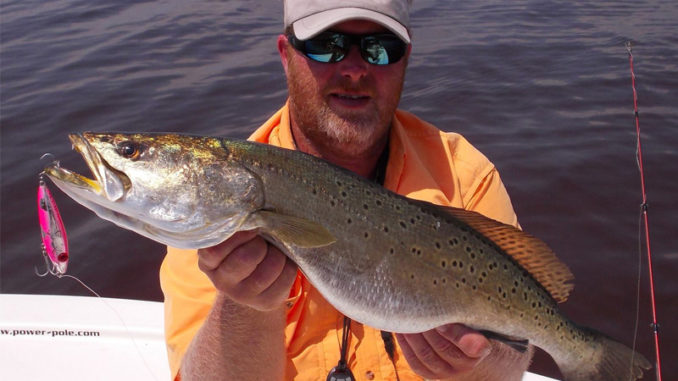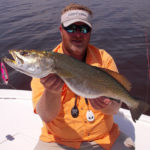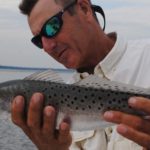
Surface strike of a big red or speck is a trip
Nothing compares to an upper-slot or slightly larger red drum taking a topwater bait. The fish is large enough to be impressive on its own. But when it pushes up behind that bait and rolls to take it, that is truly something to behold.
Even after enjoying the spectacle numerous times, I still hold my breath from when I first see the push of water to when I feel the fish grab the lure. It is so intense it jacks up my adrenaline. It makes the hairs on the back of my neck stand up.
Sure, the strike of other fish is also nice. But something about the strike of a big pup that really does it for me. Their mouth is on the bottom of their head instead of the front. So they have to roll at least on their side to strike anything on the surface.
When a puppy drum charges a lure and rolls for the strike, it makes a small wave that may actually push the lure away from it and cause the fish to miss. This seems to happen more often with larger fish. These misses appear to be frustrating to the fish. It’s just as frustrating to fishermen. Drum don’t light up like billfish or some of the offshore gamefish. But if they did, some would be glowing brightly after missing a lure two or three times.
Sometimes, it’s the angler’s fault as much as the fish’s
As fishermen, we have a part in this attack ballet, too. And it is simply to keep the lure moving steadily to help the fish catch it. This sounds pretty easy. But it’s difficult to do when you’re caught up in the moment, watching the fish charge and swipe at the lure. Often, it looks like the fish has caught the lure. But until you can feel the fish’s weight, it hasn’t. And setting the hook before the fish has the lure is a big mistake.
This self control can be difficult to master. Every year, I see experienced fishermen miss fish because they get excited and try to set the hook before the fish strikes. This is at least slightly embarrassing. And it also makes for fish dinners that are more slaw, grits and hushpuppies than fish.
Trout are also fun to catch on topwaters, but they can be frustrating too. They usually swipe at the lures and miss or get lightly foul-hooked and pull free before being led to the net. They also show themselves just before grabbing the lure. This can create excitement that causes fishermen to react too quickly and try to set the hook before the fish has the lure. Once again, you have to feel the weight of the fish before you can set the hook.
Lots of different topwater lures will draw vicious strikes
Rapala Skitterwalks, Bomber Badonk-A-Donks, Heddon Zara Spooks and several series of MirrOlures are popular topwater lures. I am most familiar with the MirrOlures and will use them as my examples. My suggestion to those who prefer the other brands is to look for similar characteristics.
I like the MirrOlure Top Dog and Top Pup for most of my puppy drum fishing. The difference between the two is size. These are made of a dense plastic, with a single, low-frequency rattle. They ride a little deeper in the water and require a little more effort to walk the dog.
The Popa Dog is a cousin that also has a concave lip design. I suggest it for those fishermen just learning to walk the dog with surface lures. This one attracts attention even when simply popped and retrieved in a straight line. Several experienced fishermen prefer the Popa Dogs when reds and trout are reluctant to bite.
I like the She Dog and She Pup for speckled trout. Again, the difference is size. These lures are made of a lighter, thinner plastic, with multiple high-frequency rattles. They ride a little higher in the water. They are easier to move, and I think can be presented more subtly.
Soft plastic topwater lures are also good options
For those who wish to fish topwaters but prefer soft plastics, give D.O.A. Chug Heads a try. These are cupped, soft-plastic heads that fit over the front of D.O.A. shad tails, jerkbaits, curlytails and paddletails. When fished on just a hook — I like a wide-gap worm hook, giving it a little keel to make sure it runs correctly — the combination of these heads and soft plastics can be retrieved in a straight line across the surface and popped to create more attention.
The correct fishing equipment also helps work topwaters to insure better action. I like fast tip rods, like the Star Seagis line, as they require less effort to get a lure to walk the dog. I like a 7- or 7 ½-footer to add a little casting distance. At one time, many fishermen thought you could only walk the dog when using baitcasting reels, but with most spinning reels now available with instant anti-reverse, spinning reels work fine.
Choose your line wisely
There is a bit of a debate regarding line for topwater fishing. Some fishermen say monofilament is better because its inherent stretch helps prevent pulling lures out of the mouths of striking fish. That may be true, at least to a point, but the inherent stretch of mono also requires more effort to get the lure to walk the dog.
I like superbraid lines for the running line, with one to two feet of fluorocarbon or low visibility monofilament line at the end for a leader. In murky water, low-visibility mono is fine, but in areas with clear water the lower visibility of fluorocarbon often produces more strikes.
I would suggest giving topwaters a try and getting ready to have some fun. This year, the pups and trout have hit on top all summer and should become even more aggressive as the water cools into the fall. Be careful; it is addicting. If the charge of a nice red drum attacking a topwater doesn’t spike your adrenaline and get you fired up, you probably should put down your rod, pick up your phone and immediately dial 911. You may have a serious medical ailment and just not know it yet.
Click here to read about “almost topwater” fishing for specks.






Be the first to comment